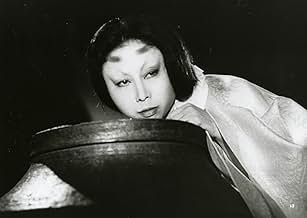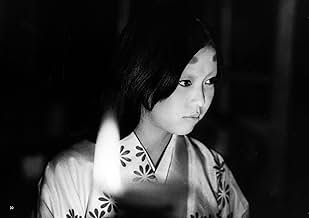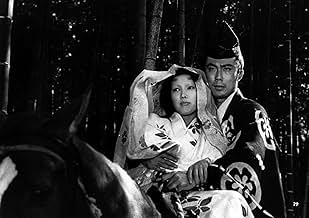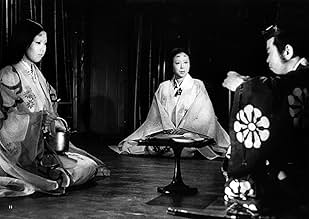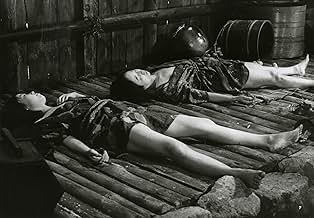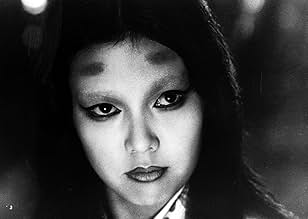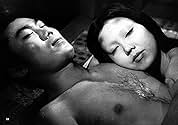CALIFICACIÓN DE IMDb
7.7/10
9.4 k
TU CALIFICACIÓN
Dos mujeres son violadas y asesinadas por soldados samuráis. Pronto reaparecen como fantasmas vengativos que seducen y asesinan brutalmente a los samuráis que pasan.Dos mujeres son violadas y asesinadas por soldados samuráis. Pronto reaparecen como fantasmas vengativos que seducen y asesinan brutalmente a los samuráis que pasan.Dos mujeres son violadas y asesinadas por soldados samuráis. Pronto reaparecen como fantasmas vengativos que seducen y asesinan brutalmente a los samuráis que pasan.
- Dirección
- Guionista
- Elenco
- Premios
- 2 premios ganados en total
- Dirección
- Guionista
- Todo el elenco y el equipo
- Producción, taquilla y más en IMDbPro
Opiniones destacadas
This is the best ghost movie I have ever seen, and highly unusual. It has gorgeous black and white cinematography, an exotic Japanese feudal setting, and a wide variety of visual and emotional effects. The characters move with the ritual formality that I love in certain Japanese films, and the story moves on with the ruthless intensity of a Noh drama.
The final scene is thrilling. The cinematic supernatural effects are sparingly used and startling.
The final scene is thrilling. The cinematic supernatural effects are sparingly used and startling.
Shot in black and white, this film has some unique imagery to accompany the creepy haunting.
Very much in the style of Kwaidan and other Japanese supernatural films of the 1960's. And very much a traditional Japanese ghost story where ghosts and evil spirits inhabit a world of logic alien to the real world. Western ghosts stories usually have the spirits think as living people do. Japanese spirits behave in bizarre ways that are much more disturbing.
The film follows the two spirits of a murdered wife and mother-in-law as they proceed to kill and drink the blood of any samurai that passes their neighborhood. The film, while very well made, is slightly routine at this point. When the husband returns a war hero, the film becomes poetic as he is assigned the task of eliminating the "monster" that is killing samurai. His encounters with his now demonic wife and mother comprise the rest of the film.
A truly excellent film. Any fan of the new Japanese horror films should see where they come from.
Very much in the style of Kwaidan and other Japanese supernatural films of the 1960's. And very much a traditional Japanese ghost story where ghosts and evil spirits inhabit a world of logic alien to the real world. Western ghosts stories usually have the spirits think as living people do. Japanese spirits behave in bizarre ways that are much more disturbing.
The film follows the two spirits of a murdered wife and mother-in-law as they proceed to kill and drink the blood of any samurai that passes their neighborhood. The film, while very well made, is slightly routine at this point. When the husband returns a war hero, the film becomes poetic as he is assigned the task of eliminating the "monster" that is killing samurai. His encounters with his now demonic wife and mother comprise the rest of the film.
A truly excellent film. Any fan of the new Japanese horror films should see where they come from.
First of all, I would LOVE to know why this classic of Japanese 60's cinema is NOT in VHS or better yet, DVD, format in Region 1 format???
It's a real shame, as it is a perfect pairing with Onibaba(which was a terrifying double bill in San Francisco in 1978, thereabouts). It explores the touchy subject of revenge, revenge for terrible deeds done to the women, and how perfectly they exact their revenge from the grave. Guaranteed you will never hear the rustling sounds of bamboo ever the same again.
This is a movie for adults, as the subject matter is intense. It is an indictment of how women were and are treated in warfare, and the horrifying toll it takes on everyone.
I highly recommend this film. If you can locate it-for some odd reason it is extremely hard to get, and it deserves a much wider audience.
It's a real shame, as it is a perfect pairing with Onibaba(which was a terrifying double bill in San Francisco in 1978, thereabouts). It explores the touchy subject of revenge, revenge for terrible deeds done to the women, and how perfectly they exact their revenge from the grave. Guaranteed you will never hear the rustling sounds of bamboo ever the same again.
This is a movie for adults, as the subject matter is intense. It is an indictment of how women were and are treated in warfare, and the horrifying toll it takes on everyone.
I highly recommend this film. If you can locate it-for some odd reason it is extremely hard to get, and it deserves a much wider audience.
Some obvious similarities to Shindo's earlier ONIBABA, as a woman and her mother-in-law are raped by samurai, and turn to supernatural forces to seek their revenge. Shindo uses an impressive array of tricks to maintain the unsettling, creepy atmosphere -- sparse Noh-style staging, bold chiaroscuro lighting, avant-garde soundtrack, abrupt time cuts, wire work, superimpositions and other special effects. It's a very atmospheric kaidan, almost Gothic in tone. Rape is of course a disturbingly common occurrence in Japanese cinema, but here Shindo uses it as the groundwork for a decidedly feminist agenda. The film does have a few pacing issues, particular during the erotic portions in the middle (although some of it is lovely). I thought more could have been done with this story, but the visual aspects and the mood make it memorable.
While watching 'Kuroneko,' I must admit I was a little distracted by what were, to me, anyway, stylistic issues: The beautiful black-and-white photography was so vivid and made clear so many little details, in contrast to which the story and the action was delivered in broad, stylized strokes. Something about this didn't work for me - the image, somehow, was too unforgiving on the simply conceived story...not to mention the makeup effects. When a shot of thrillingly real roaring fire at the opening is followed by a shot of the burned bodies, two actresses with, essentially, charcoal rubbed on parts of their arms and legs, and lumpy fake blood spread on their throats...well, it hurt my ability to get into the world of the movie. As did sequences of the plot where the characters' actions didn't follow normal human psychology ("But if he recognized her, wouldn't he say something?") If the image hadn't been so vivid I wouldn't have had to keep thinking of them as actors in a stilted, stylized script. But I did. So sue me. Maybe that's culture clash - maybe the dramatic stylization is direct from the Japanese tradition and would have felt natural in its own way to someone from Japan. Well. I'm not Japanese.
But the important thing here is that, while the movie's horror, while I was watching it, was negligible because of all the above...in the days following, I found myself more and more haunted by some of the truly eerie imagery and the undertones of the plot. To return home, having become a man, and find that your family has turned to demons - demons who might sometimes, partially, still be your family, but will never talk about it...there are shadows of a powerful nightmare in there.
The fight sequence in the rushes, and the slow processions through the bamboo grove, in particular, reverberate in my mind. These scenes, among others, were well supported by the excellent musical score.
I don't know what to make of the last few scenes - the movie had spent itself several times over by that point, though, and in a sense, the exact twists and turns of the plot were only of secondary importance. Watch it for its uniquely eerie atmosphere (and lovely photography), and then enjoy as it slowly settles in to your subconscious.
But the important thing here is that, while the movie's horror, while I was watching it, was negligible because of all the above...in the days following, I found myself more and more haunted by some of the truly eerie imagery and the undertones of the plot. To return home, having become a man, and find that your family has turned to demons - demons who might sometimes, partially, still be your family, but will never talk about it...there are shadows of a powerful nightmare in there.
The fight sequence in the rushes, and the slow processions through the bamboo grove, in particular, reverberate in my mind. These scenes, among others, were well supported by the excellent musical score.
I don't know what to make of the last few scenes - the movie had spent itself several times over by that point, though, and in a sense, the exact twists and turns of the plot were only of secondary importance. Watch it for its uniquely eerie atmosphere (and lovely photography), and then enjoy as it slowly settles in to your subconscious.
¿Sabías que…?
- TriviaThe movie was placed in competition at the 1968 Cannes Film Festival, but the festival was canceled due to the civil unrest events of May 1968 in France.
- ErroresWhen the cat crawls over the bodies after the fire, the mother can be seen to breathe.
- ConexionesFeatured in Ebert Presents: At the Movies: Episode #2.15 (2011)
Selecciones populares
Inicia sesión para calificar y agrega a la lista de videos para obtener recomendaciones personalizadas
- How long is Black Cat?Con tecnología de Alexa
Detalles
- Tiempo de ejecución
- 1h 39min(99 min)
- Color
- Relación de aspecto
- 2.35 : 1
Contribuir a esta página
Sugiere una edición o agrega el contenido que falta


